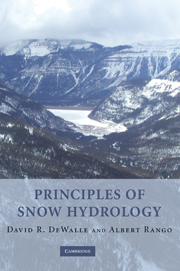Book contents
- Frontmatter
- Contents
- Preface
- 1 Introduction
- 2 Snow climatology and snow distribution
- 3 Snowpack condition
- 4 Ground-based snowfall and snowpack measurements
- 5 Remote sensing of the snowpack
- 6 Snowpack energy exchange: basic theory
- 7 Snowpack energy exchange: topographic and forest effects
- 8 Snowfall, snowpack, and meltwater chemistry
- 9 Snowmelt-runoff processes
- 10 Modelling snowmelt runoff
- 11 Snowmelt-Runoff Model (SRM)
- 12 Snowpack management and modifications
- Appendix A Physical constants
- Appendix B Potential solar irradiation theory
- Index
- Plate Section
- References
2 - Snow climatology and snow distribution
Published online by Cambridge University Press: 18 August 2009
- Frontmatter
- Contents
- Preface
- 1 Introduction
- 2 Snow climatology and snow distribution
- 3 Snowpack condition
- 4 Ground-based snowfall and snowpack measurements
- 5 Remote sensing of the snowpack
- 6 Snowpack energy exchange: basic theory
- 7 Snowpack energy exchange: topographic and forest effects
- 8 Snowfall, snowpack, and meltwater chemistry
- 9 Snowmelt-runoff processes
- 10 Modelling snowmelt runoff
- 11 Snowmelt-Runoff Model (SRM)
- 12 Snowpack management and modifications
- Appendix A Physical constants
- Appendix B Potential solar irradiation theory
- Index
- Plate Section
- References
Summary
One of the most fundamental aspects of snow hydrology is an understanding of the processes that lead to snowfall and the eventual distribution of a snowpack on the landscape. The factors that lead to the formation of snowfall are generally discussed in the beginning sections of this chapter. Since snowfall once formed, unlike rain, is quite easily borne by the wind and redistributed across the landscape before finally coming to rest to form a snowpack, the basic principles controlling blowing snow are also reviewed. Finally, the interception of snow by vegetation, that can have a profound effect on the amount and timing of snow that accumulates into a snowpack beneath a plant canopy, is described in the last section of the chapter.
Snowfall formation
The occurrence of snowfall in a region is generally dependent upon several geographic and climatic factors: latitude, altitude, the distance from major water bodies, and the nature of regional air mass circulation (McKay and Gray, 1981). General discussions of the climatic factors affecting snowfall formation and precipitation are given by Sumner (1988) and Ahrens (1988). Latitude and altitude largely control the temperature regime of a region and dictate where it is cold enough for snowfall to occur. Virtually no snowfall occurs in low latitudes where the heat balance at the Earth's surface causes air temperatures to average well above freezing during winter. Since air temperature declines with altitude, higher altitudes generally mean lower air temperatures and greater opportunity for snowfall to occur.
- Type
- Chapter
- Information
- Principles of Snow Hydrology , pp. 20 - 47Publisher: Cambridge University PressPrint publication year: 2008



